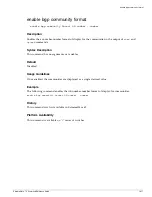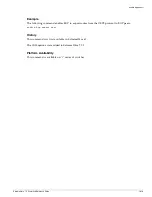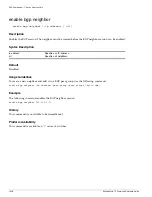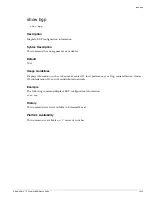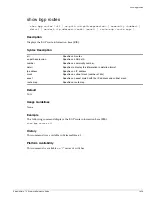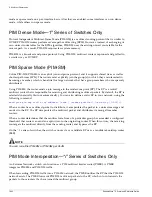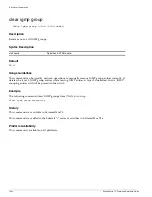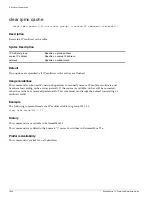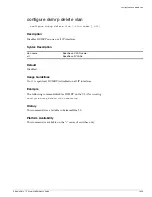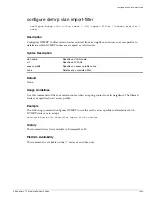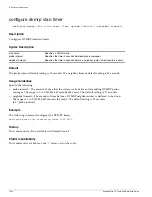
ExtremeWare 7.5 Command Reference Guide
1931
23
IP Multicast Commands
IP multicast routing is a function that allows a single IP host to send a packet to a group of IP hosts.
This group of hosts can include devices that reside on the local network, within a private network, or
outside of the local network.
IP multicast routing consists of the following functions:
•
A router that can forward IP multicast packets
•
A router-to-router multicast protocol [for example, Distance Vector Multicast Routing Protocol
(DVMRP) or Protocol Independent Multicast (PIM)]
•
A method for the IP host to communicate its multicast group membership to a router [for example,
Internet Group Management Protocol (IGMP)]
NOTE
You must configure IP unicast routing before you configure IP multicast routing.
IGMP is a protocol used by an IP host to register its IP multicast group membership with a router.
Periodically, the router queries the multicast group to see if the group is still in use. If the group is still
active, a single IP host responds to the query, and group registration is maintained.
IGMP is enabled by default on the switch. However, the switch can be configured to disable the
generation of period IGMP query packets. IGMP query should be enabled when the switch is
configured to perform IP unicast or IP multicast routing.
DVMRP—
“i”
Series of Switches Only
Distance Vector Multicast Routing Protocol (DVMRP) is a distance-vector protocol that is used to
exchange routing and multicast information between routers. Like RIP, DVMRP periodically sends the
entire routing table to its neighbors.
DVMRP has a mechanism (flood and prune) that allows it to prune and graft multicast trees to reduce
the bandwidth consumed by IP multicast traffic.
Protocol Independent Multicast (PIM) is a multicast routing protocol with no inherent route exchange
mechanism. The
“i”
series of switches support both dense mode and sparse mode operation; the
“e”
series of switches support spare mode operation. On the
“i”
series of switches, you can configure dense
Summary of Contents for ExtremeWare 7.5
Page 402: ...402 ExtremeWare 7 5 Command Reference Guide VLAN Commands ...
Page 470: ...470 ExtremeWare 7 5 Command Reference Guide QoS Commands ...
Page 490: ...490 ExtremeWare 7 5 Command Reference Guide NAT Commands ...
Page 826: ...826 ExtremeWare 7 5 Command Reference Guide Commands for Status Monitoring and Statistics ...
Page 1090: ...1090 ExtremeWare 7 5 Command Reference Guide Security Commands ...
Page 1386: ...1386 ExtremeWare 7 5 Command Reference Guide Wireless Commands ...
Page 1436: ...1436 ExtremeWare 7 5 Command Reference Guide EAPS Commands ...
Page 1568: ...1568 ExtremeWare 7 5 Command Reference Guide ESRP Commands ...
Page 1844: ...1844 ExtremeWare 7 5 Command Reference Guide IGP Commands ...
Page 1930: ...1930 ExtremeWare 7 5 Command Reference Guide BGP Commands i Series Switches Only ...
Page 2022: ...2022 ExtremeWare 7 5 Command Reference Guide IP Multicast Commands ...
Page 2066: ...2066 ExtremeWare 7 5 Command Reference Guide IPX Commands i Series Platforms Only ...
Page 2082: ...2082 ExtremeWare 7 5 Command Reference Guide ARM Commands BlackDiamond Switch Only ...
Page 2094: ...2094 ExtremeWare 7 5 Command Reference Guide Remote Connect Commands ...
Page 2174: ...2174 ExtremeWare 7 5 Command Reference Guide PoS Commands BlackDiamond Switch Only ...
Page 2372: ...2372 ExtremeWare 7 5 Command Reference Guide LLDP Commands ...
Page 2422: ...2422 ExtremeWare 7 5 Command Reference Guide H VPLS Commands BlackDiamond Switch Only ...
Page 2528: ...2528 ExtremeWare 7 5 Command Reference Guide MPLS Commands BlackDiamond Switch Only ...

